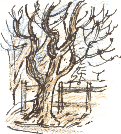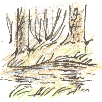Back to Barwick
Monday, 26th January 2004
Richard Bell's Wild West Yorkshire nature diary

 Previous Page | This Month | Home
Page | Next Page
Previous Page | This Month | Home
Page | Next Page 

 A
flask of coffee gives me a welcome excuse for a pause at the halfway
point on a walk I'm checking out at Barwick in Elmet,
east of Leeds. I find a bough of a hawthorn to sit on at a corner
of Kiddal Wood, which seems especially peaceful
in comparison with the busy A64 Leeds-York road that runs alongside
it. A
flask of coffee gives me a welcome excuse for a pause at the halfway
point on a walk I'm checking out at Barwick in Elmet,
east of Leeds. I find a bough of a hawthorn to sit on at a corner
of Kiddal Wood, which seems especially peaceful
in comparison with the busy A64 Leeds-York road that runs alongside
it.
 When
I'm checking walks I miss a lot of the wildlife because I'm so focused
on the directions. Within a few minutes a nuthatch
flies to the trunk of the old oak tree in front of me. When
I'm checking walks I miss a lot of the wildlife because I'm so focused
on the directions. Within a few minutes a nuthatch
flies to the trunk of the old oak tree in front of me.
But I'm soon back to pathfinding and, as part of this walk zig-zags
across open fields, my directions read like a treasure map of the
featureless stubble:
Two
hundred yards after passing the wood there is a post, and precious
little else, to tell you where to turn left (east). In a further
100 yards another post directs you to turn sharp right (south).
In another 200 yards it's left (east) again, then 150 yards and
sharp right (south) . . .
 One
signpost stands on the crest of a ridge on this magnesian limestone
scarp. Three lapwings fly off as I stomp towards
it along the narrow path across the winter wheat. One
signpost stands on the crest of a ridge on this magnesian limestone
scarp. Three lapwings fly off as I stomp towards
it along the narrow path across the winter wheat.
Potterton Beck
Potterton Beck flows down a fold in the ridge
from a scrubby piece of woodland by the A64, marked 'Jacob's Well'
on the map. As I walk upstream at first the beck is well defined,
flowing amongst the trees to my left, but when I come to a small
piece of rough ground, disturbing a few sheep, the stream bed, now
a shallower, grassy v-shaped ditch, is bone dry.
At the other side of the rough ground the stream appears again,
narrower but flowing as normal. There's no sign of a man-made culvert
so I guess the stream has carved itself a channel underground: dissolved
itself a channel underground might be a better way to put it, as
slightly acid rain or groundwater can, over time, dissolve limestone.
Magnesian Limestone
 The
creamy coloured magnesian limestone of this ridge
was laid down in a dying sea some 250 million years ago in the Permian
period when Britain was in a desert region of the supercontinent
Pangaea. Magnesian limestone contains dolomite,
CaMg(CO3)2, a double
carbonate of magnesium and calcium. The
creamy coloured magnesian limestone of this ridge
was laid down in a dying sea some 250 million years ago in the Permian
period when Britain was in a desert region of the supercontinent
Pangaea. Magnesian limestone contains dolomite,
CaMg(CO3)2, a double
carbonate of magnesium and calcium. 

richard@willowisland.co.uk

 Previous Page | This Month | This
day in 2001 | Home Page |
Next Page
Previous Page | This Month | This
day in 2001 | Home Page |
Next Page 

|

 Previous Page
Previous Page A
flask of coffee gives me a welcome excuse for a pause at the halfway
point on a walk I'm checking out at Barwick in Elmet,
east of Leeds. I find a bough of a hawthorn to sit on at a corner
of Kiddal Wood, which seems especially peaceful
in comparison with the busy A64 Leeds-York road that runs alongside
it.
A
flask of coffee gives me a welcome excuse for a pause at the halfway
point on a walk I'm checking out at Barwick in Elmet,
east of Leeds. I find a bough of a hawthorn to sit on at a corner
of Kiddal Wood, which seems especially peaceful
in comparison with the busy A64 Leeds-York road that runs alongside
it. When
I'm checking walks I miss a lot of the wildlife because I'm so focused
on the directions. Within a few minutes a nuthatch
flies to the trunk of the old oak tree in front of me.
When
I'm checking walks I miss a lot of the wildlife because I'm so focused
on the directions. Within a few minutes a nuthatch
flies to the trunk of the old oak tree in front of me. One
signpost stands on the crest of a ridge on this magnesian limestone
scarp. Three lapwings fly off as I stomp towards
it along the narrow path across the winter wheat.
One
signpost stands on the crest of a ridge on this magnesian limestone
scarp. Three lapwings fly off as I stomp towards
it along the narrow path across the winter wheat.


 The
creamy coloured magnesian limestone of this ridge
was laid down in a dying sea some 250 million years ago in the Permian
period when Britain was in a desert region of the supercontinent
Pangaea. Magnesian limestone contains dolomite,
CaMg(CO3)2, a double
carbonate of magnesium and calcium.
The
creamy coloured magnesian limestone of this ridge
was laid down in a dying sea some 250 million years ago in the Permian
period when Britain was in a desert region of the supercontinent
Pangaea. Magnesian limestone contains dolomite,
CaMg(CO3)2, a double
carbonate of magnesium and calcium.